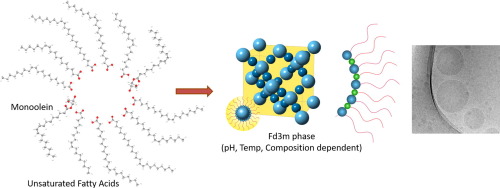当前位置:
X-MOL 学术
›
J. Colloid Interface Sci.
›
论文详情
Our official English website, www.x-mol.net, welcomes your
feedback! (Note: you will need to create a separate account there.)
Micellar Fd3m cubosomes from monoolein - long chain unsaturated fatty acid mixtures: Stability on temperature and pH response.
Journal of Colloid and Interface Science ( IF 9.4 ) Pub Date : 2020-01-16 , DOI: 10.1016/j.jcis.2020.01.041 Celesta Fong 1 , Jiali Zhai 2 , Calum John Drummond 2 , Nhiem Tran 2
Journal of Colloid and Interface Science ( IF 9.4 ) Pub Date : 2020-01-16 , DOI: 10.1016/j.jcis.2020.01.041 Celesta Fong 1 , Jiali Zhai 2 , Calum John Drummond 2 , Nhiem Tran 2
Affiliation

|
HYPOTHESIS
Control of the nanostructure of self-assembled systems may be achieved through manipulation of surfactant molecular packing and interfacial curvature. In order to phase engineer the inverse micellar cubosomes in some monoolein-fatty acid systems, lipids with wedge shaped molecular geometry were incorporated to promote the formation of this phase, that is of interest as potential sustained released nanocarriers.
EXPERIMENTS
Liquid crystalline nanoparticle dispersions of monoolein with some cis unsaturated fatty acids were prepared and their partial temperature-composition phase diagrams and structure were established using high throughput Small Angle X-ray Scattering (SAXS) and cryogenic transmission electron microscopy (cryo-TEM). The pH responsiveness of these systems was evaluated in the presence of phosphate buffered saline (PBS).
FINDINGS
The partial temperature-composition phase diagrams of five nanoparticle formulations containing monoolein and unsaturated fatty acids were established and identified the presence of micellar cubosomes in each of these systems. The results indicate that temperature, fatty acid concentration and structure, as well as pH all directly impact the formation and stability of this phase. Low energy inverse micellar cubic to emulsion phase transformations were identified in the monoolein with oleic acid and vaccenic acid systems at physiological temperatures that may be advantageous for staged therapeutic release strategies in nanomedicine.
中文翻译:

单油精-长链不饱和脂肪酸混合物的胶束Fd3m立方脂质体:温度和pH响应的稳定性。
假设可以通过控制表面活性剂的分子堆积和界面曲率来实现对自组装系统纳米结构的控制。为了在某些单油精-脂肪酸体系中对逆胶束立方体进行相工程设计,掺入了具有楔形分子几何形状的脂质以促进该相的形成,这是潜在的持续释放的纳米载体。实验制备了单油精与一些顺式不饱和脂肪酸的液晶纳米粒子分散体,并使用高通量小角X射线散射(SAXS)和低温透射电子显微镜(cryo-TEM)建立了它们的部分温度组成相图和结构。在磷酸盐缓冲盐水(PBS)的存在下评估这些系统的pH响应度。结果建立了包含单油精和不饱和脂肪酸的五种纳米颗粒制剂的部分温度-组成相图,并确定了每个系统中胶束立方体的存在。结果表明温度,脂肪酸浓度和结构以及pH值都直接影响该相的形成和稳定性。在单油精中,在生理温度下,用油酸和牛痘酸体系鉴定出了低能量的逆胶束立方相至乳液相的转变,这可能有利于纳米药物的分阶段治疗释放策略。
更新日期:2020-01-17
中文翻译:

单油精-长链不饱和脂肪酸混合物的胶束Fd3m立方脂质体:温度和pH响应的稳定性。
假设可以通过控制表面活性剂的分子堆积和界面曲率来实现对自组装系统纳米结构的控制。为了在某些单油精-脂肪酸体系中对逆胶束立方体进行相工程设计,掺入了具有楔形分子几何形状的脂质以促进该相的形成,这是潜在的持续释放的纳米载体。实验制备了单油精与一些顺式不饱和脂肪酸的液晶纳米粒子分散体,并使用高通量小角X射线散射(SAXS)和低温透射电子显微镜(cryo-TEM)建立了它们的部分温度组成相图和结构。在磷酸盐缓冲盐水(PBS)的存在下评估这些系统的pH响应度。结果建立了包含单油精和不饱和脂肪酸的五种纳米颗粒制剂的部分温度-组成相图,并确定了每个系统中胶束立方体的存在。结果表明温度,脂肪酸浓度和结构以及pH值都直接影响该相的形成和稳定性。在单油精中,在生理温度下,用油酸和牛痘酸体系鉴定出了低能量的逆胶束立方相至乳液相的转变,这可能有利于纳米药物的分阶段治疗释放策略。











































 京公网安备 11010802027423号
京公网安备 11010802027423号